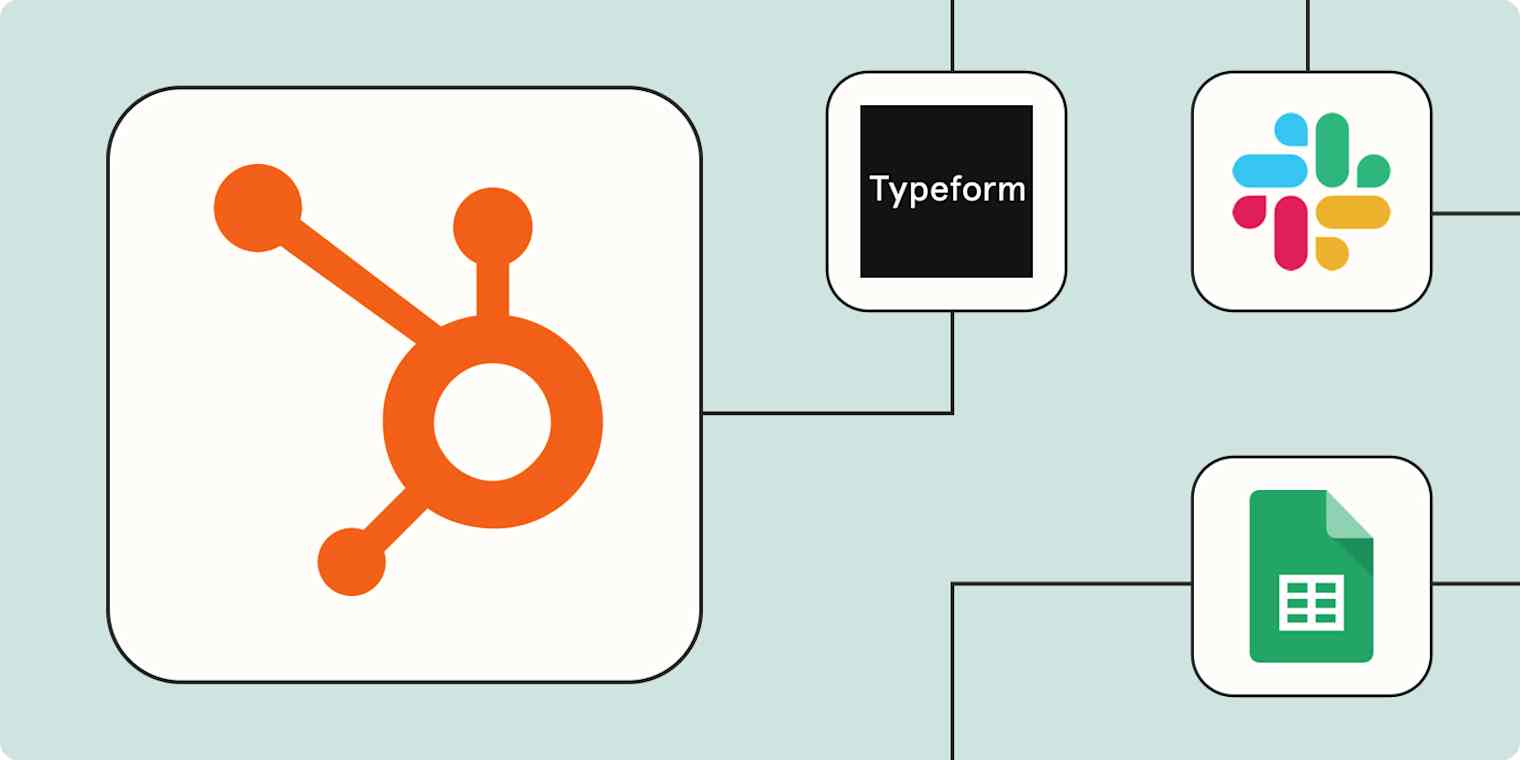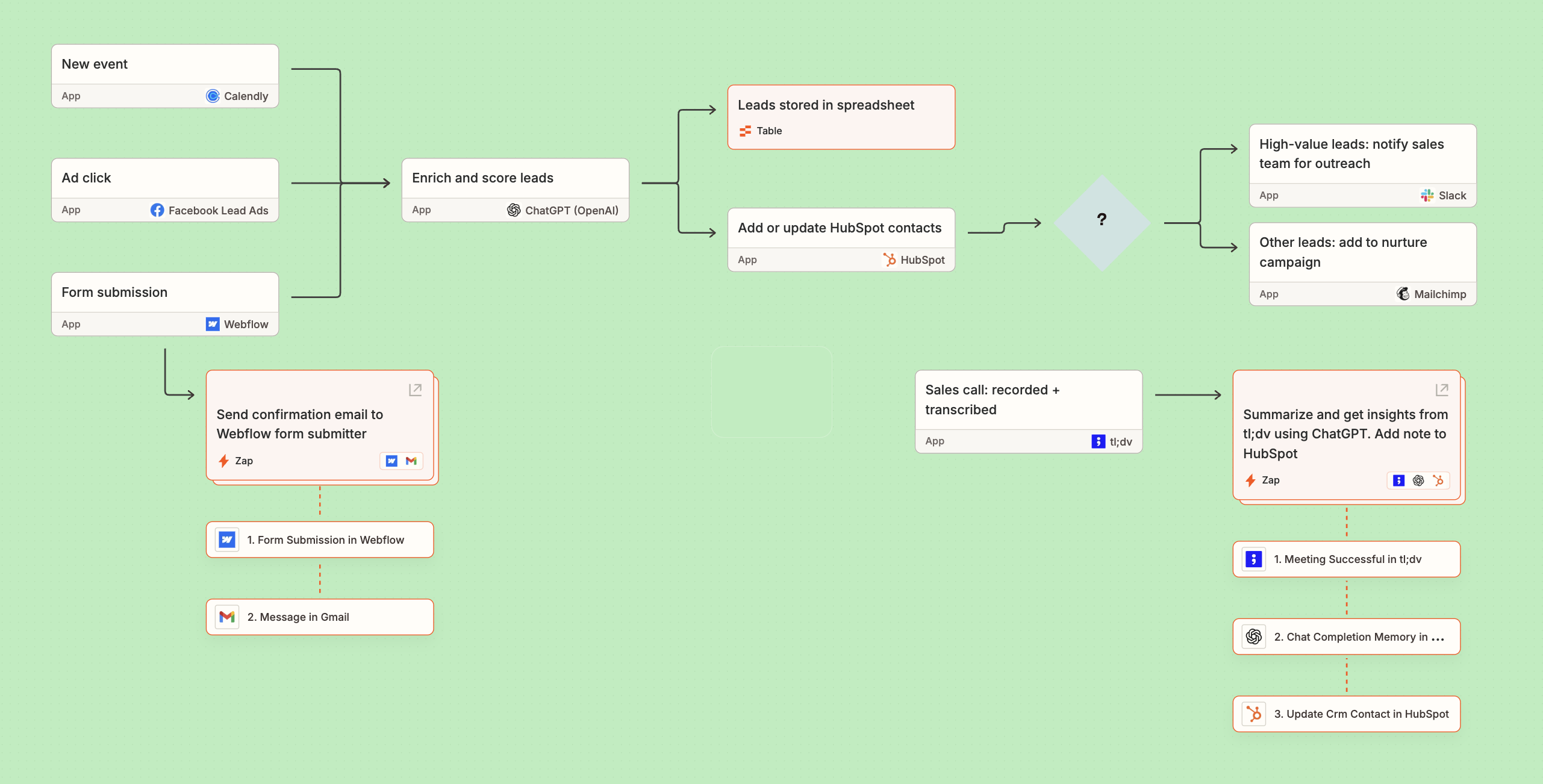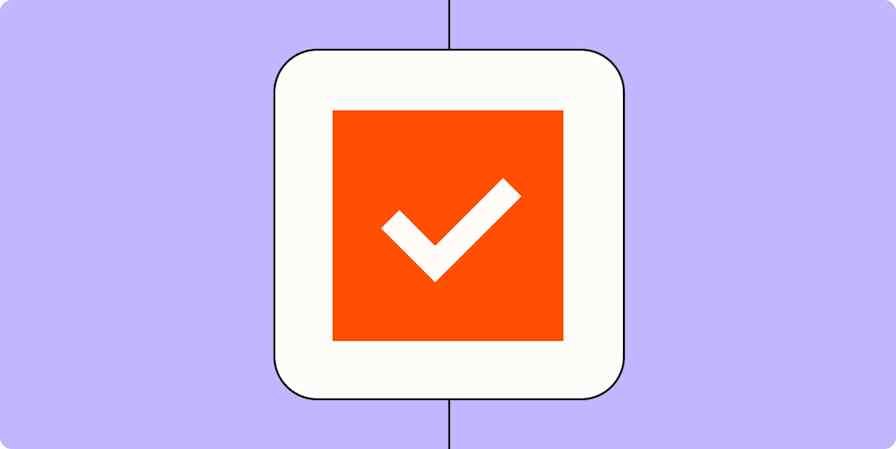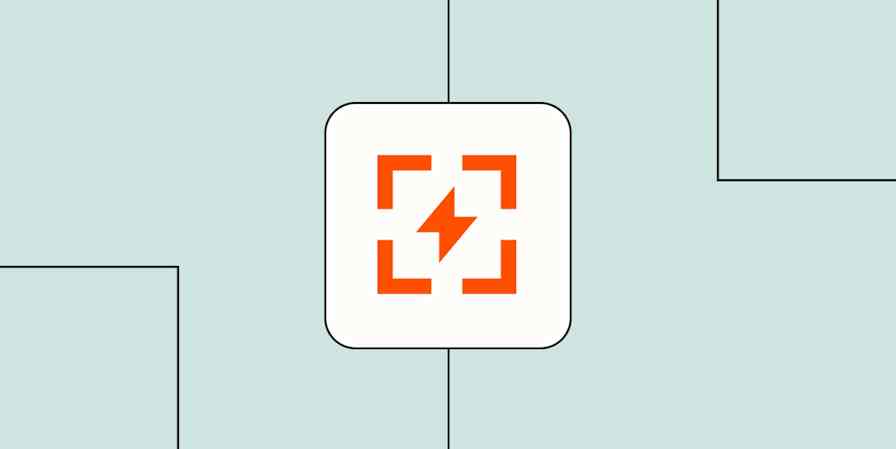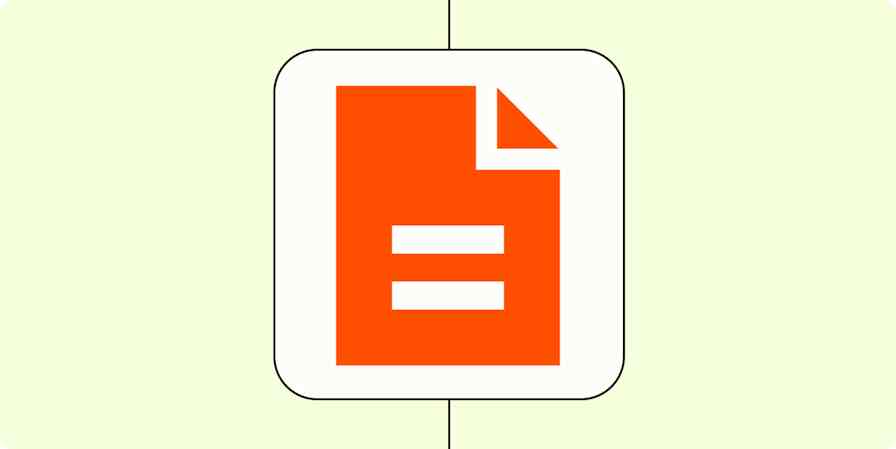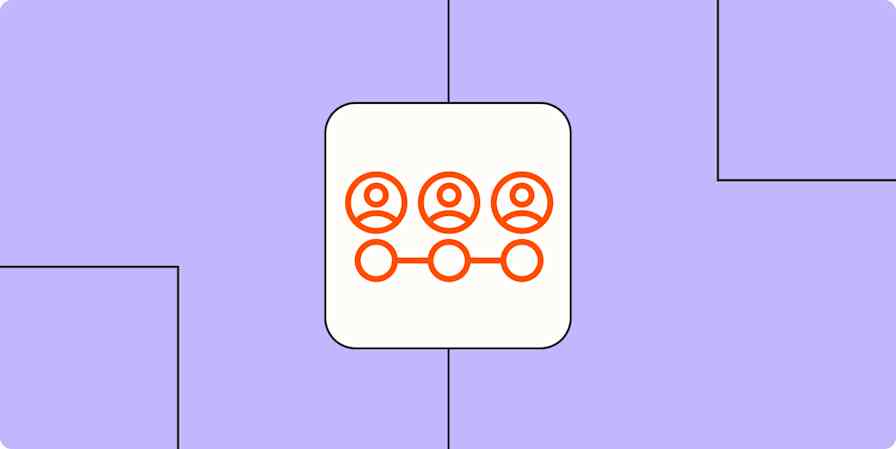Your business is only as successful as your customers are satisfied—which means you need a reliable (and scalable) process for finding, selling to, and communicating with them. That's why HubSpot is the leading customer relationship management (CRM) software. It offers a holistic suite of hubs for marketing, sales, customer service, operations, and content management that you can mix and match to suit your needs.
But as your business grows, managing your customer-facing processes manually can still take up too much of your time. Importing new leads from multiple sources, backing up HubSpot customer data to a spreadsheet, and keeping the right salespeople in the loop can quickly become a full-time job—which leaves you less time for actually building relationships with customers.
You can bridge the gap by combining Zapier and HubSpot. Our custom automated workflows (called Zaps) can send critical information between HubSpot and your other most-used apps. Here's how.
Zapier is the most connected AI orchestration platform—integrating with thousands of apps from partners like Google, Salesforce, and Microsoft. Use interfaces, data tables, and logic to build secure, automated, AI-powered systems for your business-critical workflows across your organization's technology stack. Learn more.
Table of contents
Connect HubSpot with a spreadsheet
Spreadsheets are great tools for storing and managing all kinds of data, from lead contact information to sales data to product details. If you use HubSpot form submissions to create new lead or customer profiles in HubSpot, why not add that information to a spreadsheet at the same time?
Storing your most important information in a spreadsheet lets you sort and analyze that data in a flexible, customizable format while creating redundancy to keep that data safe.
But while redundancy is great for data storage, it's not the best use of your time. Double data entry gets old fast—unless you use automation.
These integrations record each new HubSpot form entry or new contact as a new spreadsheet row in Google Sheets or Zapier Tables.
Save new HubSpot form submissions to Google Sheets rows
HubSpot + Google Sheets
More details
Need to get your HubSpot form submissions into Google Sheets, but don't want to manually transfer your data? No problem! This integration automatically saves each new form entry to a row in a specified spreadsheet for you.
Record new contacts from HubSpot lists in Google Sheets spreadsheets
HubSpot + Google Sheets
More details
HubSpot is excellent for managing leads and tracking marketing performance. Sometimes, though, it is helpful to have your data in a raw format that you can crunch yourself. This Zap will record every new contact to a HubSpot list to a Google Sheets spreadsheet, giving you the flexibility to slice and dice your data for your needs.
Create records in Zapier Tables from new HubSpot contacts in list
HubSpot + Zapier Tables
More details
Effortlessly organize your contacts with this simple workflow that connects HubSpot and Zapier Tables. Whenever you add a new contact to a list in HubSpot, a record will be created in the specified Zapier Tables, ensuring that your contacts data stays up-to-date and easily accessible. Save time and maintain a well-structured contact list with this seamless integration.
Or, if your team often adds new contacts directly to a spreadsheet, you can use this Zap to create or update a HubSpot contact automatically. That way, your CRM information is always up to date without any extra effort on your part.
Create HubSpot contacts for new Google Sheets rows
Google Sheets + HubSpot
More details
Your customer base is a changing, evolving structure, but that doesn't mean you can't automate behavior around predictable events to save yourself the work! This integration, for instance, will watch Google Sheet for any row updates and will send each one to HubSpot where your contact list will be cross-referenced and a match will be updated or a new contact will be created if none is found. Work smarter and reclaim your time with Zapier automation!
Update HubSpot contacts from new Zapier table records
Zapier Tables + HubSpot
More details
Stay organized and keep your contact information up-to-date with this seamless workflow. When new records are added to Zapier Tables, your HubSpot contacts will be created or updated. Save time and reduce manual data entry by using this efficient solution for managing your contacts.
Keep HubSpot up to date
HubSpot is your central hub for prospect and customer information—so to keep it current, you probably pull data from various sources. If you find yourself spending too much time manually copying information from other apps into HubSpot, automation is the answer.
Add data to HubSpot from meetings and events
Most people don't decide to buy your product or service after a single touchpoint, which is why it's crucial to stay in touch with prospects after meetings. If someone joins you for an introductory or demo call, you'll want to add them to your CRM so your team can follow up.
But it can be hard to remember to update your CRM after each meeting, especially since you're busy organizing your notes and sending thank-you emails. These Zaps take care of the busy work for you by automatically creating a new HubSpot contact anytime a new appointment is booked in your meeting scheduling app of choice.
Create or update Hubspot contacts for new Calendly invitees
Calendly + HubSpot
More details
Want to keep in touch with people after you have meetings with them? Keeping up with them in your CRM is a great way to continue the relationship. This Zapier integration takes care of that for you, automatically creating new HubSpot contacts from new Calendly invitees to help you keep the relationship going.
Add or update HubSpot contacts from new Acuity Scheduling appointments
Acuity Scheduling + HubSpot
More details
Create or update your HubSpot marketing contacts from new Acuity Scheduling appointments automatically, once this integration is set up. Zapier can monitor your Acuity Scheduling account for new appointments and can create or update HubSpot contacts from the client data as they make bookings.
Create Hubspot contacts from new appointments in Zoho Bookings
Zoho Bookings + HubSpot
More details
Manage your contacts with Bookings and Hubspot through this integration. This integration can create a new contact in Hubspot every time a new appointment is created. Nurture better relationships with your customers with this feature.
Add data to HubSpot from forms
Forms are a great way to collect contact information from leads and requests from customers. But if you're getting a high rate of form submissions (a good problem to have!), it can be hard to stay on top of that data.
Instead of spending hours each week exporting important information, use one of these Zaps to keep your CRM up to date automatically. Anytime a new form is submitted in form apps like Webflow or Typeform, on your Squarespace site, or even in a form you built with HubSpot, these workflows will create a new HubSpot record or contact to match. You can even run the form information through ChatGPT to enrich or score leads before adding them to HubSpot.
Send new Webflow submissions to HubSpot forms
Webflow + HubSpot
More details
Spending too much time just moving your information from Webflow over to HubSpot? Use this integration to save yourself effort. Once active, it will automatically trigger for every new submission you receive on a Webflow form, submitting it to your chosen HubSpot form at the same time.
Create or update HubSpot contacts from new entries on Typeform
Typeform + HubSpot
More details
Want to make sure customer data is always up to date, no matter how quickly it comes in through Typeform? Set up this Zap and we'll keep up with even the busiest forms. Once active, every new entry to Typeform will trigger the automation, creating a HubSpot contact in response (or updating an existing one) and making sure all your details are carried over accurately for each and every one.
Create or update HubSpot contacts from new Squarespace Forms form submissions
Squarespace Forms + HubSpot
More details
Requesting customer information via a form on Squarespace Forms? Don't waste time manually keeping the information up-to-date across your various apps. Every time a new form is received from your Squarespace Forms site, this Zap will automatically create or update a contact in HubSpot.
Create deals for new form submissions in HubSpot
HubSpot
More details
When someone fills out a form on your site, you'll want to add a deal to track their conversion to customer. This integration automatically creates deals when there are new form submissions in HubSpot. You won't have leads falling through the cracks anymore.
Enrich new Typeform entries with ChatGPT and add a note in HubSpot
Typeform + ChatGPT (OpenAI) + HubSpot
More details
Get more context about your customers without the detective work. This integration will enrich your form submissions with additional information. Whenever you receive a new Typeform submission, this Zap will find additional information with ChatGPT and attach a note to a HubSpot contact. We've included a prompt to get you started, but feel free to write your own!
Add data to HubSpot from ad and conversion tools
Don't let your paid ad campaigns go to waste by forgetting to send new leads to your CRM! Consolidating prospects' contact information into one place means you can nurture leads systematically without worrying about anyone falling through the cracks.
Time is always precious when it comes to following up on leads, but that's especially true when the lead comes from social media or Google search, where distractions abound. Let these Zaps import new leads instantly from Facebook Leads Ads or Google Ads to HubSpot so you can follow up promptly.
Update HubSpot contacts with new Facebook Lead Ads leads
Facebook Lead Ads + HubSpot
More details
Reacting to user engagement as it happens helps ensure conversion. Zapier's Facebook Lead Ads-HubSpot integration will populate your contact lists as each new name comes in: Whenever you receive a new response to your Facebook Lead Ads, this Zap will trigger and send the information to HubSpot, either creating a new contact or updating one if there's a match. Start developing those relationships!
Create contacts in HubSpot for new leads from Google Ads
Google Ads + HubSpot
More details
Use this integration to automatically import new leads from Google Ads into HubSpot as contacts. This Zap saves you from the tedious task of duplicate data entry!
Add new LinkedIn Lead Gen Form submissions as HubSpot form submissions
LinkedIn Ads + HubSpot
More details
LinkedIn is a fast way to generate new leads, but you have to master your follow-up to get them to close. Zapier can automate this for you! Once you have set up this integration, new leads generated via LinkedIn Ads will be added as new HubSpot form submissions, effortlessly triggering your favorite email follow-up.
You can even use automation to help make your job easier by enriching lead data before adding those contacts to HubSpot. These Zaps run new leads through Clearbit before creating new HubSpot contacts, making sure each new lead's profile is accurate and ready for prompt follow-up.
Enrich Facebook leads with Clearbit and add to HubSpot
Facebook Lead Ads + Clearbit + HubSpot
More details
Automatically enrich and add new leads to your CRM. Whenever a new lead is captured through Facebook Lead Ads, Clearbit finds additional details about the person, and then a new contact is created in HubSpot. This integration helps you build a more complete customer profile with minimal effort.
Enrich Google Ads leads with Clearbit and add them to a HubSpot list
Google Ads + Clearbit + HubSpot
More details
Automatically enhance your lead data and streamline contact management. When a new lead submits a form in Google Ads, Clearbit finds additional details about the person, and the enriched contact is then added to a list in HubSpot.
Enrich LinkedIn Ads leads with Clearbit and add them to a HubSpot list
LinkedIn Ads + Clearbit + HubSpot
More details
Automatically enhance and organize your LinkedIn Ads leads by enriching them with Clearbit before adding them to a HubSpot list. This integration helps you gather deeper insights on new leads and streamline your marketing workflows.
Pro tip: Zapier's built-in tools can make your HubSpot workflows even more powerful. For example, you might use Formatter by Zapier to clean up lead data before sending it to your CRM. Or, a filter step could prevent form submissions with missing emails or generic domains from being added to HubSpot. You can even use a path step to send high-value leads to sales, and others to nurture campaigns.
Record and summarize call notes automatically
If you use a call transcription tool to take notes on your sales calls, it's a good idea to port at least some of that information into your CRM. That way, you can keep all information and notes related to each contact in one place.
But manually downloading transcript data and uploading it into HubSpot is not only a drain on your team's time, but it also risks human error and out-of-date records. Instead, use automation to update your HubSpot contacts (or even create new ones) for every new recording in tools like Fathom and tl;dv.
Create or update HubSpot contacts whenever new recordings occur in Fathom
Fathom + HubSpot
More details
Start enhancing your business efficiency with this automation that links Fathom and HubSpot. Whenever you have a fresh recording in Fathom, this workflow will instantly update or create a new contact in HubSpot. It's a flawless way to ensure your contacts' information stays up-to-date and allows you to harmonize your data across different platforms. Enjoy a streamlined process that eliminates manual data entry, saves time, and improves accuracy.
Add new tl;dv notes to create or update contacts in HubSpot
tl;dv + HubSpot
More details
Easily manage your contacts directly within HubSpot as soon as a new note is added in the tl;dv app with this handy automation. When a note is set up in tl;dv, it initiates the process of creating or updating a corresponding contact within your HubSpot database. This helps ensure your information in HubSpot remains current and accurate, reducing the need for manual data entry and enhancing your CRM effectiveness.
Create new HubSpot engagements from new Fireflies.ai meetings
Fireflies.ai + HubSpot
More details
Start streamlining your workflow with this intuitive automation. Whenever a new meeting occurs in Fireflies.ai, it triggers the creation of an engagement in HubSpot. This process allows you to efficiently manage your meetings and follow-ups by keeping your engagements updated in real time. Utilize this workflow to maintain regular contact with your clients and ensure you never miss a business opportunity.
For improved lead scoring and faster insights, you can even use AI to analyze sales call transcripts before logging the results in HubSpot. That way, you'll have a birds-eye view of each call without needing to dig into pages of transcripts.
Create or update HubSpot contacts from new ai summaries in Fathom
Fathom + HubSpot
More details
When a new AI summary is generated in Fathom, streamline your workflow by updating or creating a contact in HubSpot. This integration ensures that your HubSpot contact list is always up-to-date with the latest Fathom insights, saving you time and ensuring seamless communication.
Process tl;dv transcripts with AI and update contacts in HubSpot
tl;dv + ChatGPT (OpenAI) + HubSpot
More details
Automatically analyze meeting transcripts and update your CRM effortlessly. When a new transcript is added in tl;dv, ChatGPT processes the conversation to extract key insights, which are then used to add or update a contact in HubSpot.
Send notifications from HubSpot
There are plenty of reasons why you might want to send or receive a notification whenever someone submits your HubSpot form. Maybe you want to follow up on new leads right away or keep your team up to date on new deals as soon as they come in.
These Zaps send a channel message in your team chat app whenever a new deal or form is submitted in HubSpot. And if you get a lot of deals (congrats!), add a filter or digest step to the workflows below to avoid spamming your Slack channel with constant notifications. Stay aware of important information without needing to be glued to your HubSpot dashboard.
Get Slack notifications for new HubSpot form submissions
HubSpot + Slack
More details
Wouldn't it be great to get a Slack message every time someone fills out your HubSpot form? This HubSpot Slack integration automatically notifies you of new form submissions so you'll instantly know when you've got a new entry.
Send Slack channel messages for new deals in HubSpot
Slack
More details
Keep your team on the same page by sending out notifications whenever new deals are created in your CRM. Use this Zap to automatically send Slack messages whenever new deals are created in HubSpot. That way, your teammates will be kept in the loop while you avoid tedious manual message chores.
Send Microsoft Teams channel messages for new HubSpot contacts
HubSpot + Microsoft Teams
More details
Want to make sure your team follows up on every lead? This integration can help, automatically sending a Microsoft Teams channel message each time a new contact gets added to HubSpot. Your team will never fail to engage with a potential customer.
If email is more your speed, you might want to receive email updates of important changes to customer profiles in HubSpot. Or maybe you want to automatically send a follow-up email to the form submitter.
Either way, you can use these Zaps to send custom emails (or even draft custom emails with ChatGPT for your review) when your HubSpot account receives a form submission.
Send Gmail emails when you receive new HubSpot form responses
HubSpot + Gmail
More details
If your company has someone that needs to know when a form response is received, stop forwarding them the responses or pinging them and let Zapier do it automatically! With this integration, Zapier will send an email—to a coworker, the form submitter, whoever you need—every time you get a new form response.
Create draft emails in Microsoft Outlook when HubSpot deal stages are updated
HubSpot + Microsoft Outlook
More details
Stay on top of your HubSpot deal stages and streamline communication with this efficient workflow. When a deal stage is updated in HubSpot, a draft email will be created in Microsoft Outlook, allowing you to promptly address the necessary changes or updates. By automating this process, you can ensure faster reaction times and a more organized management of your sales pipeline.
Generate personalized responses in ChatGPT for new HubSpot form submissions
HubSpot + ChatGPT (OpenAI)
More details
With this Zap template, every time a new form is filled out in HubSpot, it generates a prompt using OpenAI. It then creates an email draft in HubSpot using ChatGPT, enabling you to effortlessly craft customized emails based on the contact details received.
Connect HubSpot to your mailing list
Your CRM is at its best when it's thorough and up to date. That means everyone subscribed to your email list should be accounted for. After all, they're excellent candidates to become paying customers.
But manually exporting your mailing list subscribers to HubSpot can be tedious, and it's easy to forget about that weekly or monthly chore. Instead, let automation handle the busy work for you.
These Zaps automatically create a new contact (or update an existing one) in HubSpot whenever you get a new subscriber in your email marketing app. Or, you can have Zapier update your HubSpot contacts when they unsubscribe to a Mailchimp email.
Create or update HubSpot contacts from new Mailchimp subscribers
Mailchimp + HubSpot
More details
Don't worry about manually adding new Mailchimp subscribers to your HubSpot contacts list because this integration takes care of that for you. Any time you get a new Mailchimp subscriber, Zapier automatically creates a new contact or updates an existing one in HubSpot.
Copy new contacts from Constant Contacts to HubSpot CRM
Constant Contact + HubSpot
More details
Say goodbye to manual data entry. This integration moves data between your contact trackers so you don't have to do. When active, it turns each new contact in Constant Contact into a a contact in HubSpot CRM, and you won't have to worry about missing one again.
Add or update HubSpot contacts with new unsubscribed Mailchimp users
Mailchimp + HubSpot
More details
Want to make sure to identify who is and isn't part of your marketing efforts from within your CRM? Use this Mailchimp-HubSpot integration and we'll keep up with those Mailchimp unsubscriptions for you. After it's been configured, the integration will trigger with each user that unsubscribes from Mailchimp, automatically updating the corresponding contact on HubSpot CRM (or creating a new one), saving you the pain of ever updating them yourself again.
And conversely, you'll want to add any new leads or customers to your mailing list so you can stay in touch with them. These Zaps add or update subscribers in your email newsletter app whenever a new form is submitted or contact is created in HubSpot. That way, you can keep your mailing list current and properly categorized without any tedious data entry.
Add or update subscribers in Mailchimp for new form submission from HubSpot
HubSpot + Mailchimp
More details
When someone shares their interests with you by filling out a form, you'll want to make sure you capture those interests to deliver targeted messaging to them. This Zapier integration will help you do just that by adding/updating subscribers when you have new form submissions in HubSpot.
Add new HubSpot contacts to Mailchimp lists
HubSpot + Mailchimp
More details
Your customers will never miss an important promotional email from you because you forgot to update your Mailchimp list. This HubSpot-Mailchimp integration automatically adds new HubSpot contacts to a Mailchimp list so you can focus on designing the perfect email campaign instead of copying your contacts list.
Create or update Flodesk subscribers for new HubSpot contacts
Flodesk
More details
Keep your Flodesk subscribers up-to-date by connecting it with HubSpot contacts. With this workflow, whenever a new contact is added in HubSpot, it will create or update the subscriber in Flodesk, ensuring your email marketing stays in sync. Save time and effort by streamlining your contact management process with this seamless automation.
Use webhooks with HubSpot
Hopefully by this point, you're inspired to create a custom automation to fit your team's workflows—but what If the app you're thinking of doesn't integrate natively with Zapier?
Don't worry; you've still got options. You can use webhooks to send data from one tool to another.
For example, maybe you use an obscure form builder to collect lead information. If that tool doesn't integrate with Zapier, you can use one of these templates to automatically detect updates from a specific URL and use that data to create (or update) a HubSpot contact. Or conversely, you can send information from new HubSpot form submissions to the tool of your choice.
Create HubSpot contacts from newly-caught webhooks
Webhooks by Zapier + HubSpot
More details
Every time a webhook is activated, this Zap automatically creates or updates a contact in HubSpot. Update your contact list with this custom workflow and save yourself from tedious data entry.
Catch new webhooks and create HubSpot contacts
Webhooks by Zapier + HubSpot
More details
When you have contact info available through webhooks that also belongs in your marketing tool, this integration can connect your tools. Once active, it will automatically catch a POST from a specific URL and create a contact in HubSpot with all the details you need.
Send HubSpot form submissions to webhooks
HubSpot + Webhooks by Zapier
More details
So you've got a new form submission in HubSpot and want to send that data to another app with a webhook? No need to write any code because this HubSpot Webhook integration automatically sends your form entries to your specified webhook.
Supercharge your CRM with automation
HubSpot is a powerful tool for managing customer relationships, but it can be hard to consolidate data and keep your CRM up to date when relying solely on manual processes. And since nurturing leads and customers depends on quick follow-ups and accurate data, it's crucial to perfect your information workflows.
Thankfully, automation makes it easy to keep your CRM organized and aligned with the rest of your tech stack. And you're not limited to two-step Zaps, either—in fact, when you build an automated system to manage your sales processes, you unlock even more potential. For example, here's how a hypothetical sales team might visualize their automated lead management system (diagrammed with Zapier Canvas):
In this example, new leads are brought in from multiple sources, enriched and scored, and added to HubSpot and a backup spreadsheet. From there, a conditional logic flow sends high-value leads to a Slack channel for immediate follow-up, while other leads are added to a nurture campaign. And as the sales team reaches out to leads, those call transcripts and notes are summarized and added back to HubSpot automatically—keeping their records up to date while letting them focus on actually turning leads into customers.
This is just the start of what you can do with HubSpot and Zapier. What will you automate first?
This article was originally published in May 2017, written by Ashley Hockney. It was most recently updated in March 2025 by Nicole Replogle.

